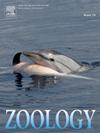异常噬人鱼 Phoronis embryolabi 的异常身体分裂和上皮结构
IF 1.6
3区 生物学
Q2 ZOOLOGY
引用次数: 0
摘要
噬孔虫是一种小型的底栖海洋无脊椎动物门,可在全球范围内大量出现。研究噬菌体的形态和解剖结构对于了解噬菌体的生物学特性和以噬菌体为主的底栖群落的功能非常重要。由于所有噬人鱼都是管栖动物,因此研究体壁的形态和超微结构是了解管的形成、生长和翻新过程的重要一步。本研究利用环氧组织学、扫描和透射电子显微镜描述了以共生体形式生活在掘地对虾洞穴中的不寻常的 Phoronis embryolabi 的身体区域化和体壁上皮的超微结构。embryolabi 的躯干由 8 个区域组成,在活体上可以清晰区分。这些区域如下:长头区、中间括约肌及其三个不同部分(腰部、上部和下部)、肌肉区、生殖区、第 7 区和安瓿。这种体型划分与胚乳藻生活方式的特异性有关。各区上皮的超微结构在厚度、腺细胞的集合和数量、上皮下细胞外基质的结构以及神经元的数量等方面都有所不同。腺细胞的能力和分布与管道的形成和重塑有关。躯干所有部位的体壁上都有两种不同类型的细菌;这表明噬菌体与细菌之间存在互利的相互作用。我们的数据表明,P. embryolabi 能够在前端而不是后端形成管道,这与之前其他噬菌体物种的情况相同。同时,对于噬菌体以及许多其他管栖无脊椎动物来说,噬菌体管的生长和重塑的特定机制仍然是未知的。本文章由计算机程序翻译,如有差异,请以英文原文为准。
Unusual body division and epithelium structure in unusual phoronid Phoronis embryolabi
Phoronida is a small phylum of benthic marine invertebrates that can occur in large numbers globally. The study of phoronid morphology and anatomy is important for understanding phoronid biology and the function of benthic communities dominated by phoronids. Because all phoronids are tube-living animals, the study of the morphology and ultrastructure of the body wall is an important step toward understanding the processes of the tube formation, growth, and renovation. This study used epoxy histology, scanning and transmission electron microscopy to describe the body regionalization and ultrastructure of the body wall epithelium of the unusual Phoronis embryolabi, which lives as a commensal in burrows of digging shrimps. The trunk of P. embryolabi consists of 8 zones, which are clearly distinguishable in living individuals. These zones are as follows: long head region, median sphincter with its three different parts (waist, upper and lower), muscular region, reproductive region, zone 7, and ampulla. Such body division can correlate with specificity of life style of P. embryolabi. The ultrastructure of the epithelium of all zones differ from each other in thickness, set and abundance of gland cells, structure of the extracellular matrix that underlies the epithelium, and abundance of neurites. The capacity and distribution of glandular cells correlate with tube formation and remodelling. Bacteria of two different types are described along body wall of all parts of the trunk; reciprocally advantageous phoronid-bacteria interaction is suggested. Our data suggest that P. embryolabi is able to build the tube at the anterior end rather than at the posterior end, as previously suggested for other phoronid species. At the same time, the certain mechanism of phoronid tube growth and remodelling is still unknown for phoronids as well as for many other tube-living invertebrates.
求助全文
通过发布文献求助,成功后即可免费获取论文全文。
去求助
来源期刊

Zoology
生物-动物学
CiteScore
3.90
自引率
0.00%
发文量
37
审稿时长
70 days
期刊介绍:
Zoology is a journal devoted to experimental and comparative animal science. It presents a common forum for all scientists who take an explicitly organism oriented and integrative approach to the study of animal form, function, development and evolution.
The journal invites papers that take a comparative or experimental approach to behavior and neurobiology, functional morphology, evolution and development, ecological physiology, and cell biology. Due to the increasing realization that animals exist only within a partnership with symbionts, Zoology encourages submissions of papers focused on the analysis of holobionts or metaorganisms as associations of the macroscopic host in synergistic interdependence with numerous microbial and eukaryotic species.
The editors and the editorial board are committed to presenting science at its best. The editorial team is regularly adjusting editorial practice to the ever changing field of animal biology.
 求助内容:
求助内容: 应助结果提醒方式:
应助结果提醒方式:


